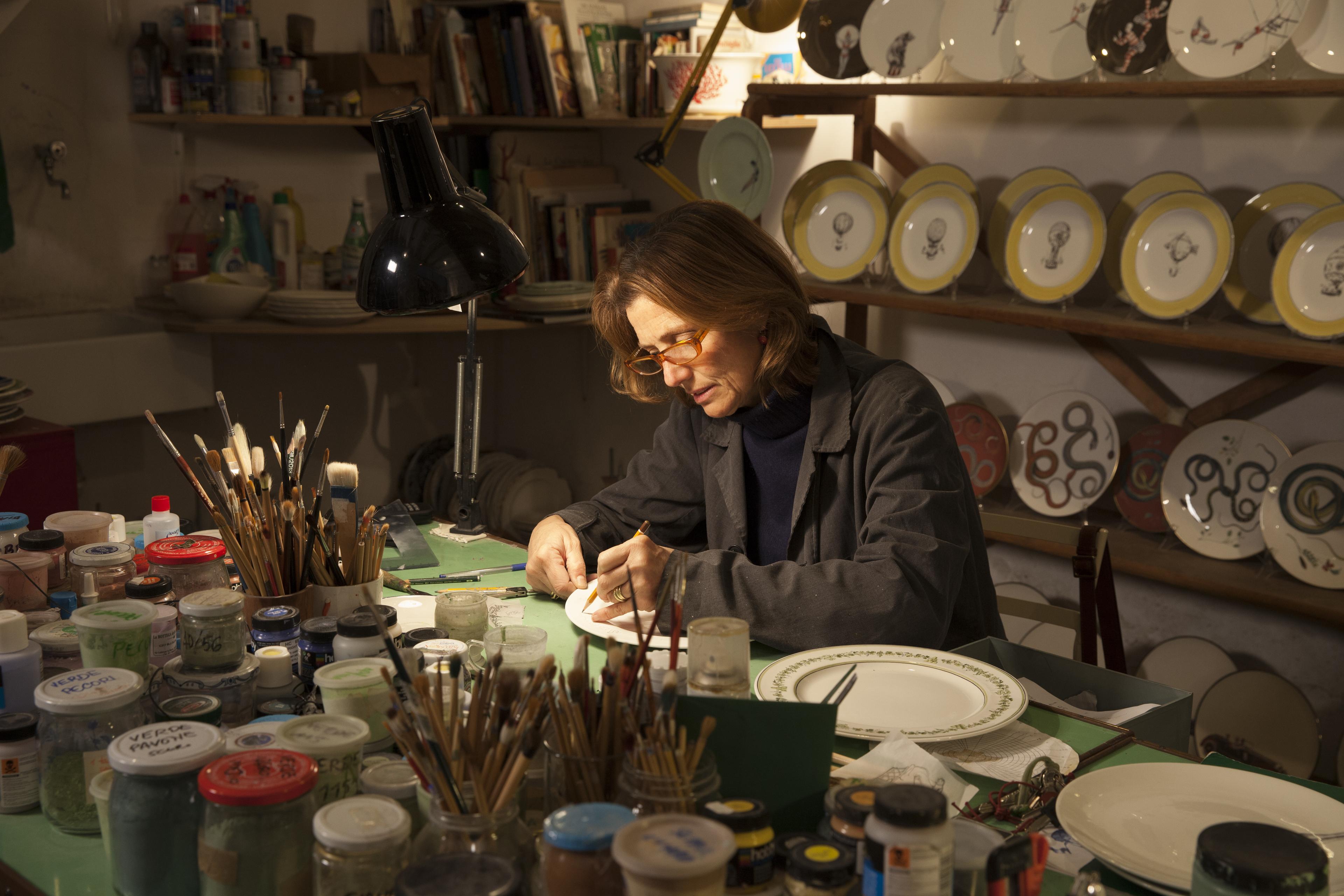
Catrame-Schreibtisch
13.335 EUR
Versandt in 2-3 Wochen

Lernen Sie Marzia De Lorenzi und Monica Cortesi kennen, die Gründerinnen der Kunsthandwerksmarke ROU Materiaal, deren Name auf Afrikaans Rohmaterialien und radikale Handarbeit bedeutet, und entdecken Sie ihre einzigartige Herangehensweise an authentische Handwerkskunst, bei der sie natürliche Materialien wie Harz und ausrangiertes Holz für die Herstellung von Einrichtungsgegenständen und Deko-Accessoires verwenden.
Der Inhalt dieser Seite wurde automatisch übersetzt. Besuchen Sie die Website auf Englisch
Marzia De Lorenzi und Monica Cortesi teilen viele Leidenschaften: Kunst, Design und die Stadt Paris. Dank ihrer engen Verbindung konnten sie 2013 ROU Materiaal gründen, eine Möbelfirma, deren Name sich aus dem Afrikaans ableitet und "Rohmaterial" bedeutet. Dies unterstreicht den unverwechselbaren Stil der Marke, der "primitive" Materialien mit einer tiefgreifenden Studie zeitgenössischer Formen und Texturen unter Verwendung von Harzen, Acryl, Stuck und Zement verbindet.
Von skulpturalen Tischen bis hin zu atemberaubenden Dekorationen werden die Stücke aus dem Holz von jahrhundertealten Bäumen hergestellt und vollständig in Italien produziert. So werden ausrangierte Materialien in zeitgenössische Stücke verwandelt, die perfekt für Häuser mit Charakter und Persönlichkeit sind.
Lesen Sie unser Interview mit Marzia und Monica in der Zeitschrift Artemest und erfahren Sie, wie die beiden zusammenkamen und eine persönliche Ästhetik schufen, die Handwerkskunst mit Kunst verbindet.
Was hat Sie zu der Entscheidung inspiriert, solch raffinierte Rohmaterialien mit afrikanischem Einfluss zu verwenden?
Wir beide Partner, obwohl wir zwei völlig unterschiedliche Karrieren haben, der eine in der Architektur, der andere im Management, haben den Wunsch geäußert, mit einem starken, strukturierten und rauen Material zu arbeiten, das durch sehr radikale Handarbeit entsteht. Der Name "ROU Materiaal" kommuniziert unsere Erforschung eines sehr alten Materials, durch seinen Klang und seinen sprachlichen Ursprung; er deutet auch einen zeitgenössischen minimalistischen Einfluss an, eine Fusion zwischen der Sprache afrikanischen Ursprungs und der nördlichen zeitgenössischen Welt.
Welches Material oder welche Technik ist unter den von Ihnen verwendeten am eigenartigsten?
Die eigentümlichste Technik ist die Verwendung von Harz, das auf ungewöhnliche und technisch "falsche" Weise gewonnen wird, um unvollkommene und zufällige Ergebnisse mit einem einzigartigen Flair zu erzielen.
Erzählen Sie uns etwas über den kreativen Prozess und die Herstellung eines Ihrer berühmtesten Stücke.
Alle unsere Stücke haben einen gemeinsamen kreativen Prozess, der die Auswahl des Rohmaterials und die Art der Harzverarbeitung umfasst. Unsere Auswahl an Rohstoffen besteht aus Massivholz von hundertjährigen Bäumen, die gefällt wurden, weil sie krank oder tot waren, und dann von der Industrie wegen ihres unvollkommenen Charakters abgelehnt wurden, den wir persönlich für sehr ausdrucksstark halten. Das Rohmaterial unseres ikonischsten Stücks, "Sezione Superbig05", wurde genau wegen seiner Ausdruckskraft ausgewählt: Es handelt sich um ein noch "frisches" Ulmenholz, das auf seiner Oberfläche dreidimensionale Ausbuchtungen aufweist, die mit Harz, Sand und Gips, der auf verschiedenen Ebenen aufgetragen wurde, veredelt wurden, um ein einzigartiges, strukturelles Stück von starkem chromatischem Wert zu schaffen.
Wie würden Sie Ihren Stil und Ihre Philosophie beschreiben?
Unser Stil ist brutalistisch und strukturiert und strebt nach einer von der Natur inspirierten Ästhetik, die durch eine menschliche Geste geformt wird, die sowohl zufällig als auch vorsätzlich ist. Wir wollen ein kraftvolles Stück Natur schaffen, das von Menschenhand zu einem zeitgenössischen Design geformt wird und eine einzigartige Ausdruckskraft besitzt, die oft durch ungewöhnliche chemische Prozesse erreicht wird. Unsere Philosophie ist die einer realisierbaren, zeitgemäßen Natur, die Emotionen für zeitgenössische und zukünftige Häuser hervorruft.
Wie wird sich ROU Materiaal in den nächsten Jahren entwickeln?
Wir erwarten, dass wir in den nächsten Jahren nationale und internationale Netzwerke von Kunstdesign-Galerien erreichen und unsere maßgeschneiderten Projekte für Privathäuser fortsetzen werden. Wir hoffen auch, die Zusammenarbeit mit renommierten Marken und Hotels fortzusetzen und ganz allgemein mit allen Umgebungen, die ein funktionelles Dekor mit einer starken emotionalen Ladung benötigen.
Welche Verbindungen fühlen Sie zu Ihrem Gebiet? Welchen Ort in Ravenna würden Sie unbedingt empfehlen?
Wir fühlen uns mit unserem Gebiet verbunden durch die Suche nach Rohstoffen, die wir bei unseren lokalen Lieferanten finden, und durch die Techniken, wie z.B. das Nachbilden des typischen "Drucks der Romagna" in einer zeitgenössischen Ästhetik auf Stoff. Die Verwendung von Harz ist absolut innovativ und betrifft vor allem die Welt der Restaurierung. Manchmal fügen wir auch Mosaikfliesen hinzu, die typisch für die byzantinische Kunst sind, die in Ravenna ihren Höhepunkt erreicht hat. Ein Besuch in San Vitale ist auf jeden Fall zu empfehlen, aber auch die historischen Druckereien der Romagna sind einen Zwischenstopp wert. Schließlich ist ein Spaziergang durch unsere Pinienwälder ein Muss: Ihre Schönheit wurde vom Dichter Lord Byron gepriesen, und die einzigartigen Düfte der Bäume und ihres Harzes verführen jeden Besucher.

Verwurzelt in jahrhundertealter italienischer Handwerkskunst und doch von ständigem Experimentiere…

Biancoperla entstand in den späten 1950er Jahren aus der Leidenschaft der Familie Sali für feine T…